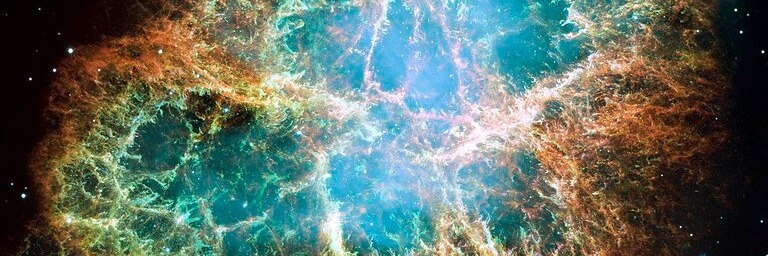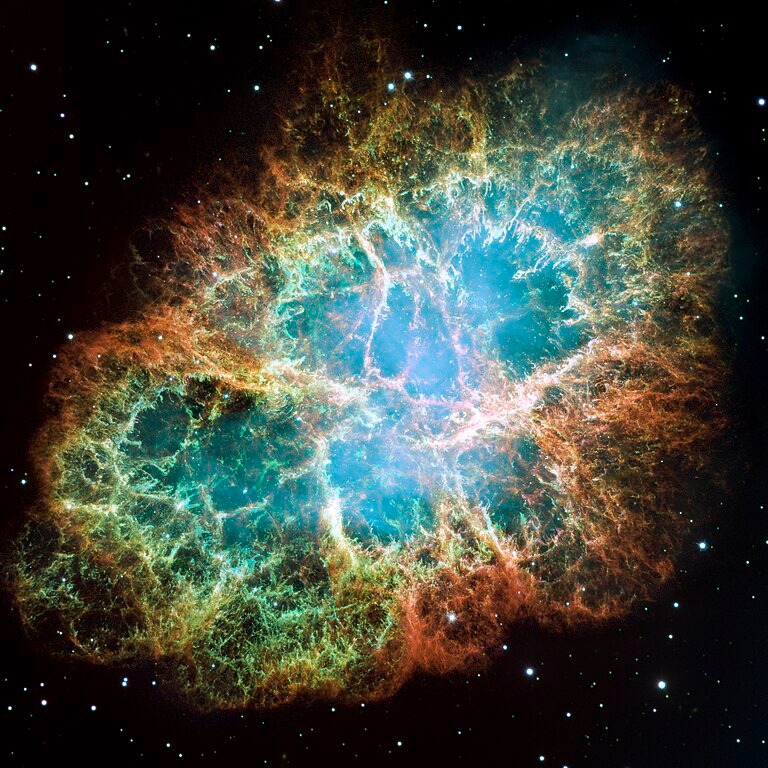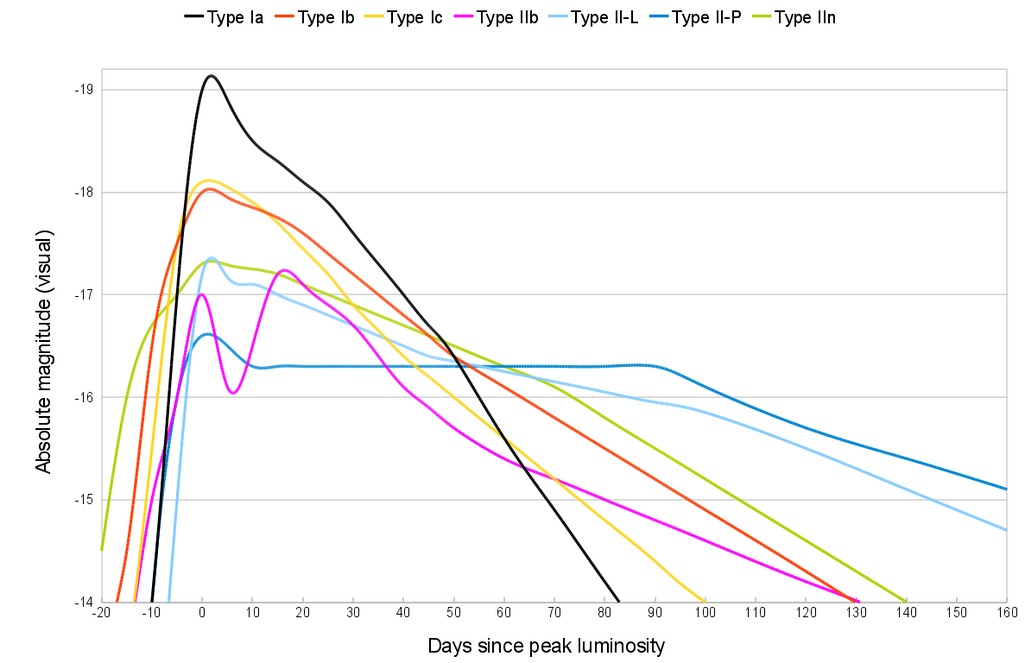A supernova is one of the most dramatic and powerful phenomena in the universe. Supernovae occur during the final stages of the life of a massive star, and can cause the release of several solar masses of material. Because of this, supernovae can reach a luminosity comparable to that of an entire galaxy, before slowly fading over the course of a few weeks or months. During a supernova, several chemical elements heavier than oxygen are produced, and the shock wave caused by the explosion can trigger the formation of new stars. However, not all supernovae are the same, and different stars and conditions result in different kinds of supernovae. It is also worth noting that not all stars end their lives with a supernova. Only white dwarves or stars over around 8 solar masses might result in a supernova, other stars at the end of their evolution only expel their outer layers without a large explosion.
Supernovae are classified according to the absorption lines of the chemical elements that appear in their spectra, and their light curve, the evolution of their luminosity over time. The main division is between type I supernovae, which lack the hydrogen lines in their spectrum, and type II supernovae, which instead have the hydrogen lines. These two types are further subdivided according to the presence of other absorption lines or the shape of their light curves.
Type Ia supernovae
Type Ia supernovae have no hydrogen lines in their spectrum, but present a strong ionized silicon absorption line. This type of supernova happens in a binary system in which one of the stars is a white dwarf, while the other one can be any kind of star. The supernova is triggered when a carbon-oxygen white dwarf that accumulates material from the companion star reaches the critical mass of 1.44 solar masses. Beyond this point, the white dwarf can’t support its mass anymore. Without a companion star, the white dwarf would collapse in a neutron star, but the presence of another star causes a large portion of the white dwarf to ignite, with the carbon and oxygen of the star quickly fusing into heavier elements. This process, called thermal runaway, causes the white dwarf to explode violently, and no remnant is left, as all the material from the star is dissipated. However, the exact process that leads to the ignition of the white dwarf is still unknown. After the explosion, a type Ia supernova reaches an absolute magnitude of -19.3, with little variation. This incredible consistency allows this type of supernova to be used to measure distances on intergalactic scales, by comparing this absolute magnitude to its apparent magnitude.
This is the most common model for type Ia supernovae, but it’s not the only one. These supernovae can also be triggered by the collision of two white dwarves, which might cause the critical mass to be exceeded. These are still classified as Type Ia supernovae. In other cases, the white dwarf that accumulates material from a companion can reach masses higher than 1.44 solar masses, and the subsequent supernova might leave a remnant. It has been proposed that this rarer kind of supernova should be classified as Type Iax.
The remnant of a supernova observed in 1006, presumably a type Ia supernova.
Type Ib and Ic supernovae
Type Ia supernovae are the only ones that are caused by thermal runaway, while every other kind is a consequence of the collapse of the core of a massive star. For this reason, type Ib, Ic, and II supernovae are collectively known as core-collapse supernovae. Type Ib and Ic supernovae happen with extremely massive stars that have already lost their outer hydrogen layer, and this explains the absence of the hydrogen lines from their spectra. However, type Ib supernovae show a non-ionized helium line, while type Ic supernovae lack this line. This means that stars that have lost both their hydrogen and helium layers result in type Ic supernovae. Due to their similarity, these two types are often grouped together as type Ibc or stripped core-collapse supernovae.
Type II supernovae
Type II supernovae show hydrogen lines in their spectra, and are caused by collapse of massive stars that have at least 8 to 10 times the mass of the Sun. These stars are massive enough to fuse elements in their core up to iron. After a core of iron and nickel is produced, no fusion into heavier elements can take place since the fusion of these elements doesn’t result in a net energy output. The iron-nickel core grows, and when it reaches a critical mass of about 1.4 solar masses, the energy generated by the fusion of elements is no longer sufficient to balance the gravitational compression caused by the upper layers, and the core suddenly implodes. The collapse is halted by the nuclear force in the inner core, and the implosion rebounces, causing an immense explosion that results in the dissipation of most of the material from the star. If the star has a mass up to around 20 solar masses, the remnant after the supernova is a neutron star, but if its mass is higher, the remnant is instead a black hole.
The Crab Nebula was formed by a type II supernova in 1054.
The subcategories of type II supernovae are classified according to their light curve. All these supernovae have a steep rise in brightness with a peak followed by a progressive decay. Type II-P supernovae show a plateau after the peak, with the luminosity decreasing slowly for some time before decaying. Type II-L supernovae instead lack this plateau, and show a quicker decrease in luminosity. This distinction is believed to be caused by a difference in how the outer hydrogen layer is expelled. For type II-L supernovae the hydrogen layer is simply ejected, while for type II-P supernovae the shock wave caused by the explosion results in hydrogen being ionized, with an increase in opacity that prevents light from escaping and keeps the luminosity high. Type II-P supernovae are the most common kind of supernovae.
Type IIn and IIb supernovae are rarer kinds of type II supernova. The type IIn shows narrow hydrogen lines, which might be a result of the expulsion of material from the star, but the light curve remains somewhat in between those of type II-P and type II-L. Type IIb supernovae instead have a different light curve, but are still classified as type II because they show weak hydrogen lines. These supernovae show an initial peak, followed by a decrease in luminosity and then a second peak, after which the brightness decreases. This might be the result of the expulsion of material from the star, which might partially obscure the view of the supernova for some time, before becoming more transparent. More peculiar kinds of supernovae with hydrogen lines are collectively classified as type IIpec.
Comparison of the light curves of different types of supernovae (Lithopsian, Wikimedia Commons, CC BY-SA 3.0).
The existence of a type III supernova has been theorized, also known as electron-capture supernova. This would occur for stars between 8 and 10 solar masses, in which the core runs out of nuclear fuel and collapses causing gravity to compress the electrons into their atomic nuclei. This would result in a supernova that leaves behind a neutron star. In 2021, it was reported that a supernova discovered in 2018 might fit this model, and if this is the case, this would be the first observation of an electron-capture supernova, and the confirmation that type III supernovae are possible.




